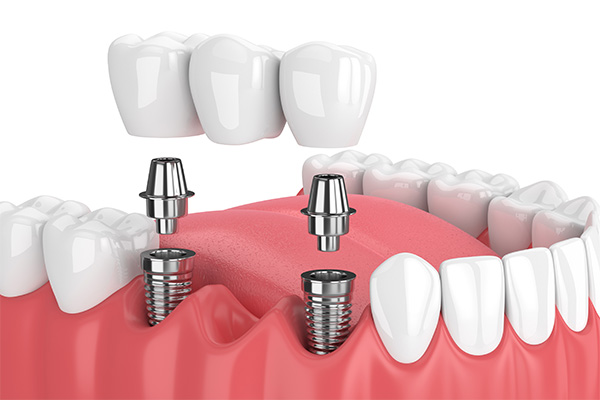Options for Replacing Missing Teeth: Are Dental Bridges Right for Me?
 If you are someone with gaps in their smile, there are many options for replacing missing teeth available to you. A dental bridge is a time-honored solution for replacing missing teeth. Similar methods for replacing teeth have been used for thousands of years.
If you are someone with gaps in their smile, there are many options for replacing missing teeth available to you. A dental bridge is a time-honored solution for replacing missing teeth. Similar methods for replacing teeth have been used for thousands of years.
A dental bridge is a single or series of false teeth, called pontics, held in place by a person’s natural adjacent teeth or dental implants. They are installed during a procedure completed by dental professionals, with one to several appointments necessary, depending on bridge type. They are most often made of porcelain or ceramic to match the natural aesthetic of teeth.
Why do I need a dental bridge?
People seek out options for replacing missing teeth for a multitude of reasons. A dental bridge is a restorative and preventative solution for several problems due to missing teeth and can provide both health and cosmetic benefits.
A dental bridge can:
- Restore your smile.
- Restore your ability to properly chew and speak.
- Prevent movement of remaining natural teeth.
- Prevent jawbone deterioration, and maintain facial structure.
What types of dental bridges are available?
There are four different types of dental bridges available. Some methods require dental surgery to place an implant, while other bridges can be placed topically by bonding them to adjacent natural teeth.
- Traditional bridges involve a false tooth, or teeth, being held in the missing tooth through dental crowns placed on each of the adjacent natural teeth.
- Cantilever bridges consist of a single false tooth and a single crown bonded to only one adjacent tooth. These bridges are not as strong as a traditional bridge and are not usually placed in the back of the mouth, where there is greater force placed upon teeth.
- Maryland bonded bridges consist of single or multiple false teeth bonded to adjacent natural teeth with metal or porcelain wings. Wings may be bonded on one or both sides of the bridge, depending on the level of support necessary.
- Implant-Supported bridges use surgically placed implants to hold a dental bridge in place. Generally, one implant is placed for each tooth included in the bridge, although in some cases, a pontic may be placed between two implants.
While different types of dental bridges are available, they may not work for every case. Speak with your dentist to find out what type of dental bridge would be the best fit for you.
Will it look like my natural teeth?
When researching options for replacing missing teeth, a common fear is that the false teeth may not match the person’s remaining natural teeth. Dental Bridges are most often made out of porcelain or ceramic to match the natural aesthetic of teeth. Your dentist will use the shape, color, and overall appearance of your remaining natural teeth, to help assure your bridge looks like a natural part of your smile.
Am I a good candidate?
While different types of dental bridges are available, they may not work for every case. Speak with your dentist to determine if a dental bridge is an option and which type would be the best fit for you.
Recent Posts
There are many options for replacing missing teeth, even if they are your front teeth that are missing. Missing front teeth can severely hurt a person’s self-esteem and confidence because the missing teeth are right where everyone can see them. However, there are solutions to that problem. Read on to learn more. Your dentist will…
If you're considering your options for replacing missing teeth, you may want to know when you should make your decision. In short, as soon as you can. Now, this is not always an option nor available at a moment's notice.Depending on the route you go, you're going to have to wait to let things heal.…
If you have a missing tooth or several missing teeth, you may wonder what your options for replacing missing teeth are. Fortunately, there are several replacement options. Dental implants are not the only option for replacing missing teeth. Continue reading to learn about the treatments available, along with the pros and cons of each treatment…


